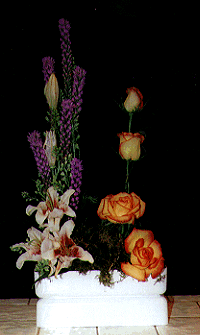|
Rittners School Of Floral Design
In Boston Presents....
 How To Make A
Parallel Vase Arrangement How To Make A
Parallel Vase Arrangement
"A parallel vase arrangement?" you ask..."What's that?"
Very simply this.....
Think back to those happy days of old when you were taking geometry in school!!
Parallel lines were defined as two (or more) lines that were side by side, but
never touched or intersected.
If we can make arrangements into triangles and S shapes and other geometric things, then it should come as no surprise that we can do parallel lines as well.
Parallel designing is often called a European style design, for many designers
from Europe popularized it.
In actuality the style itself can be traced back hundreds of years to Japan and China. The concept of two lines of flowers parallel to each other has gradually been adapted by designers throughout the world, who give it their own unique vision.
What You Will Need
Container
Foam
Spike flower buds
Liatris
Lilies
Roses
Statice
Moss

Let's start this design by placing foam into the container.
We start our flower placement by putting a line of flowers on the left side
of this design. We had some buds left over from another design...They are spikey in effect (eg. from monkshood,or delphinium, etc.)
Add some lily blossoms in front of the spike buds and down towards the base of the design.
The mechanics of the design are covered with moss.

To create greater height on the left side of the design, we add
liatris as shown in the photograph.

Let's create a second line with roses...............
Now we definitely have
parallel lines...........

The roses look a bit sparse, so let's add a little statice.
You can see, parallel designing is a very easy style to do.....
Contents can be varied to come up with an enormous assortment of possibilities.
Consider picking randomly one of each from Numbers I, II, III, & IV below:
I. For example in place of liatris and the spike flower buds consider substituting: gladiolus, miniature glads, larkspur, delphinium, forsythia branches, curly willow, ting ting, rib cycas leaves, heliconia, pussy willow, eremurus, bells of ireland.
II. In place of the lilies consider substituting: sunflowers, daffodils, carnations, fujis, anthurium, gerbera, godetia, orchids.
III. In place of the roses, consider substituting: gerbera, miniature carnations, spray roses, cornflower, miniature glads, bird of paradise, bouvardia, alstroemeria, nerines, pincushion protea.
IV. In place of statice consider substituting: ageratum, leptospermum, heather, gypsophila, solidago, solidaster.
Play with these combinations, and you have literally hundreds of designs from this one lesson!!!!!!!!!!
We hope that you really enjoyed this brief floral design lesson. At
Rittners Floral School in Boston we provide
floral design instruction that includes a wide range of different
styles and techniques. Please come and take one of our hands-on
workshop programs!!
Floral Education Center
returns you to our Floral Education Center.
Your Webmaster is Dr. Steve Rittner, who may be reached at Stevrt@tiac.net.
All photographs and text on
this page are Copyright - Rittners School,
and may not be reproduced, or used for any commercial purposes.
|